Abstract
Serum antibodies to the stratum corneum of rat oesophagus epithelium, so-called 'antikeratin antibodies', have been largely demonstrated in rheumatoid arthritis (RA). IgM and IgG antibodies to this epithelium were studied by semiquantitative immunofluorescence in 528 patients with perfectly characterised rheumatic diseases, including 178 with classical or definite RA. Histological analysis of IgG antibodies showed that only antibodies which produce a linear laminated pattern restricted to the stratum corneum (IgG antikeratin antibodies) are highly specific for RA; all the other labelling patterns are not disease specific. By a semiquantitative evaluation of the stratum corneum fluorescence intensity it was shown that the diagnostic value of IgG antikeratin antibodies closely depends on their titre and it was established in objective conditions that the sensitivity is 43.26% when the specificity reaches 99.14%. A high titre of IgG antikeratin antibodies was actually pathognomonic for RA. Both the histological and semi-quantitative analyses showed that IgM antibodies to rat oesophagus epithelium, though frequently detected, are of no diagnostic value, either for RA or for any other rheumatic disease that was studied. From a review of all the international reports on IgG antikeratin antibodies it was found that, to date, 4080 patients, including 1694 with RA, have been assayed for antikeratin antibodies by 11 different research groups. Analysis of all the results obtained under comparable technical conditions showed that IgG antikeratin antibodies constitute the most specific serological criterion for the diagnosis of RA. Furthermore, it was found that their incidence does not depend on disease duration: they are present in one third of rheumatoid factor negative patients with RA, and they seem to be related to disease severity or activity, or both. Their detection in the diagnosis of rheumatic diseases should become systematic.
Full text
PDF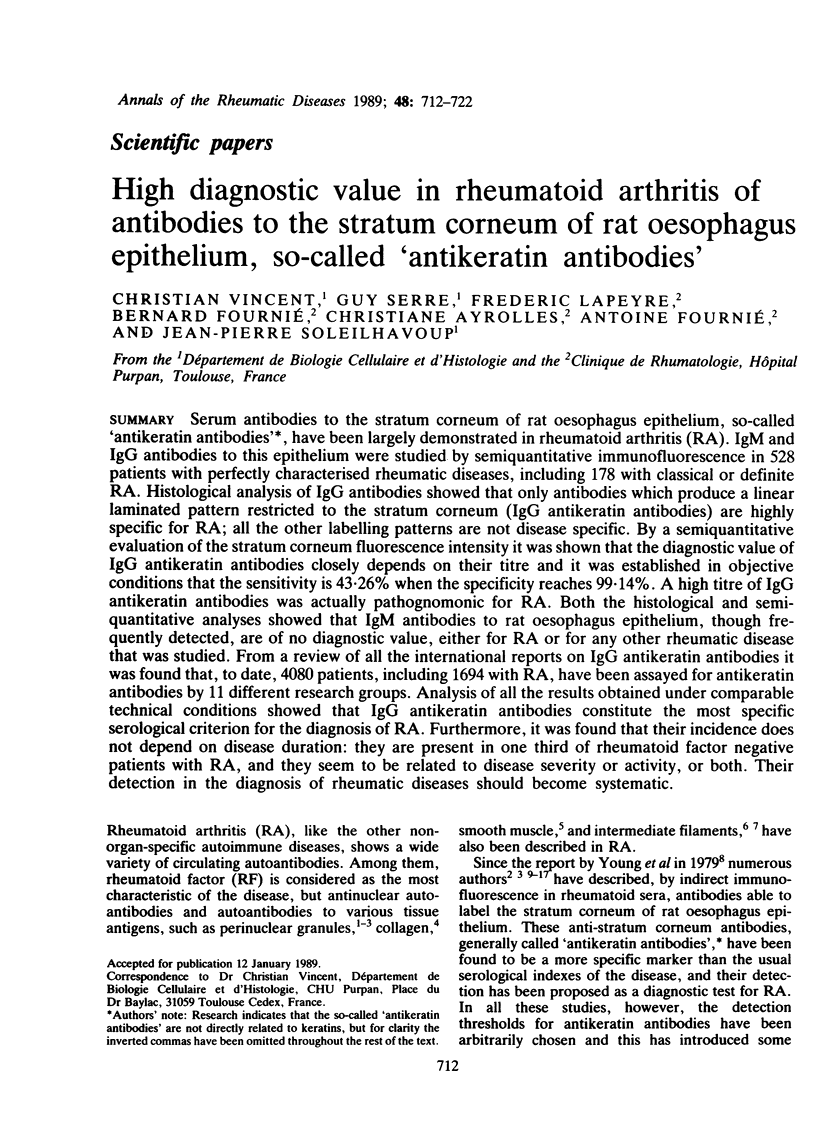
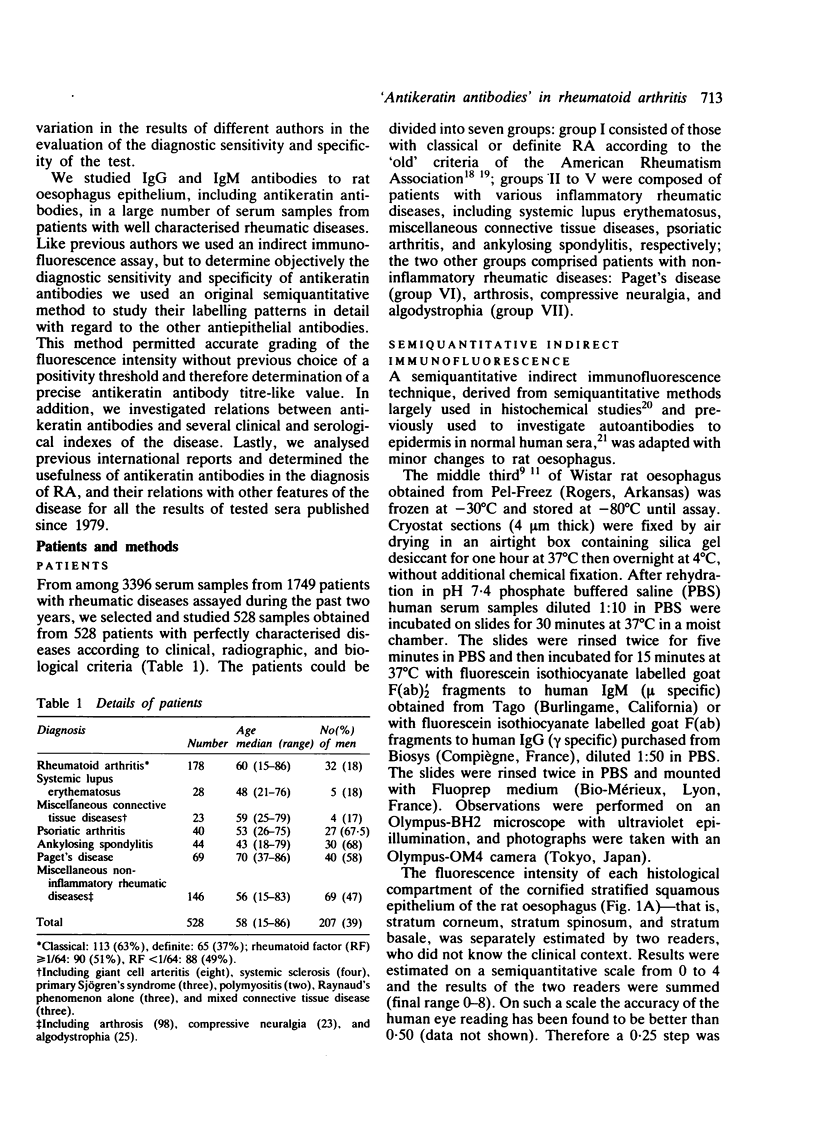
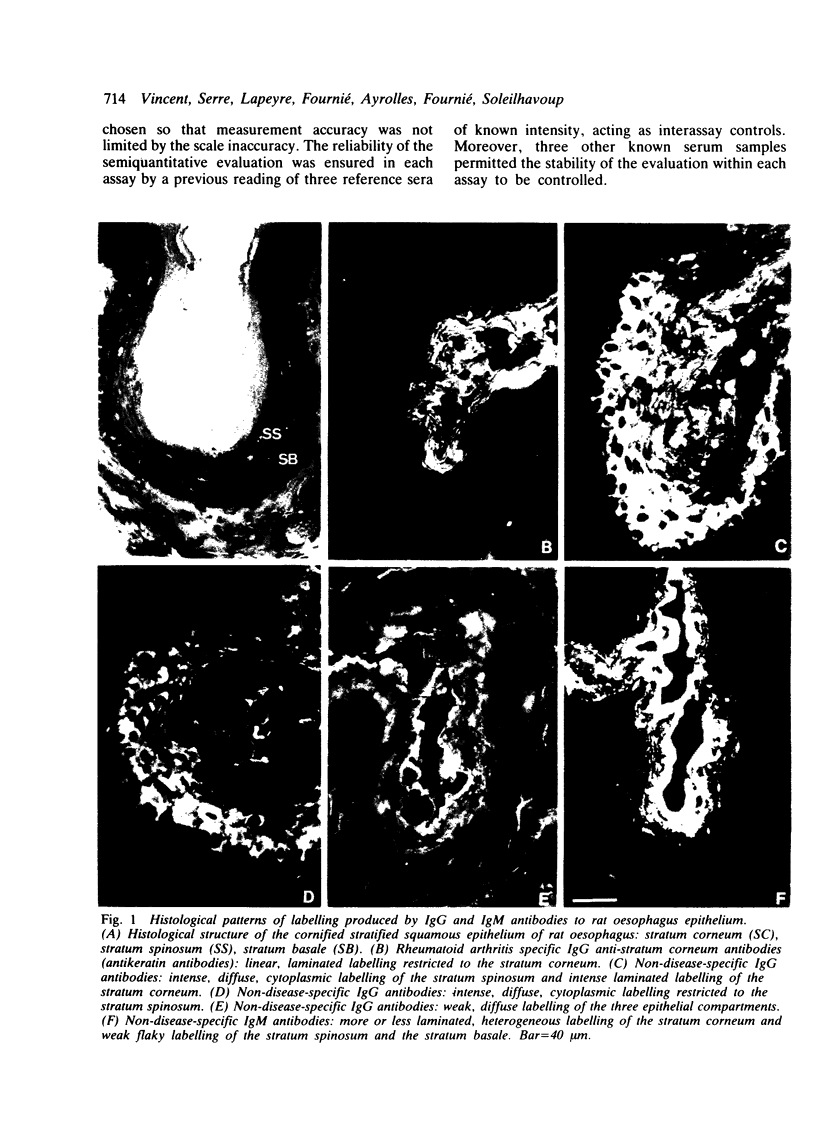
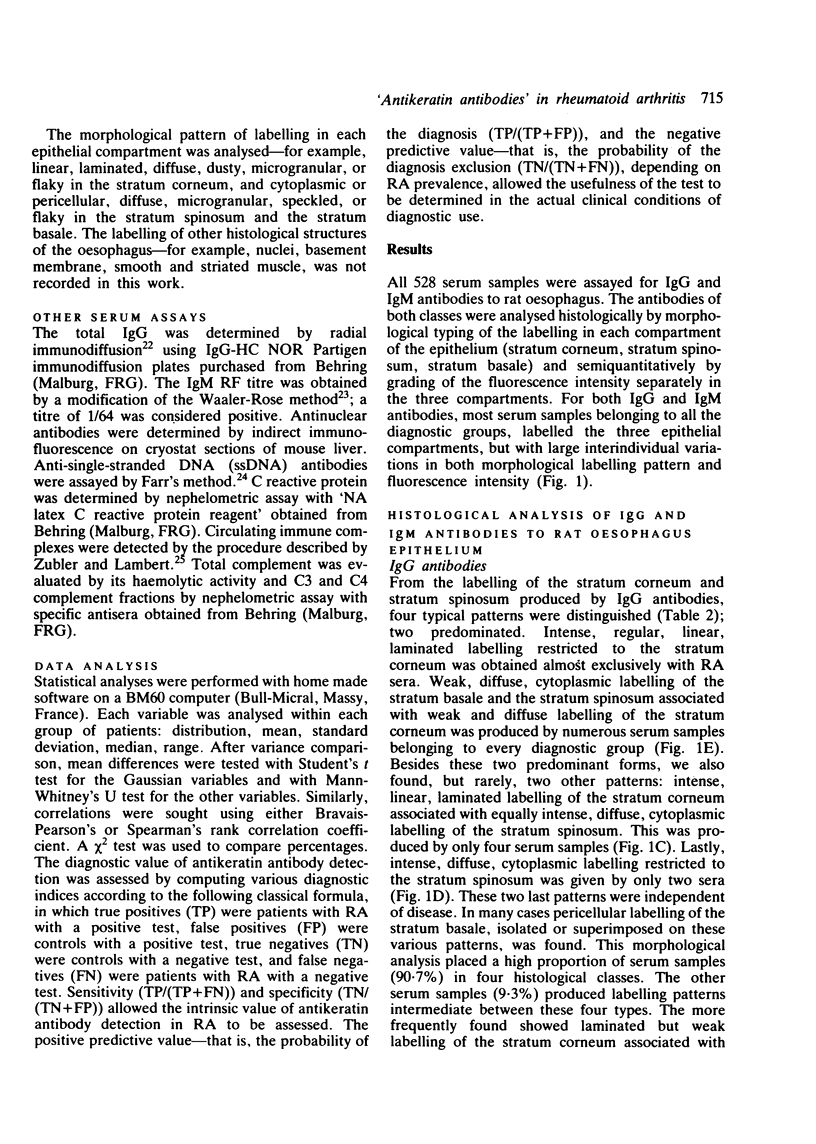
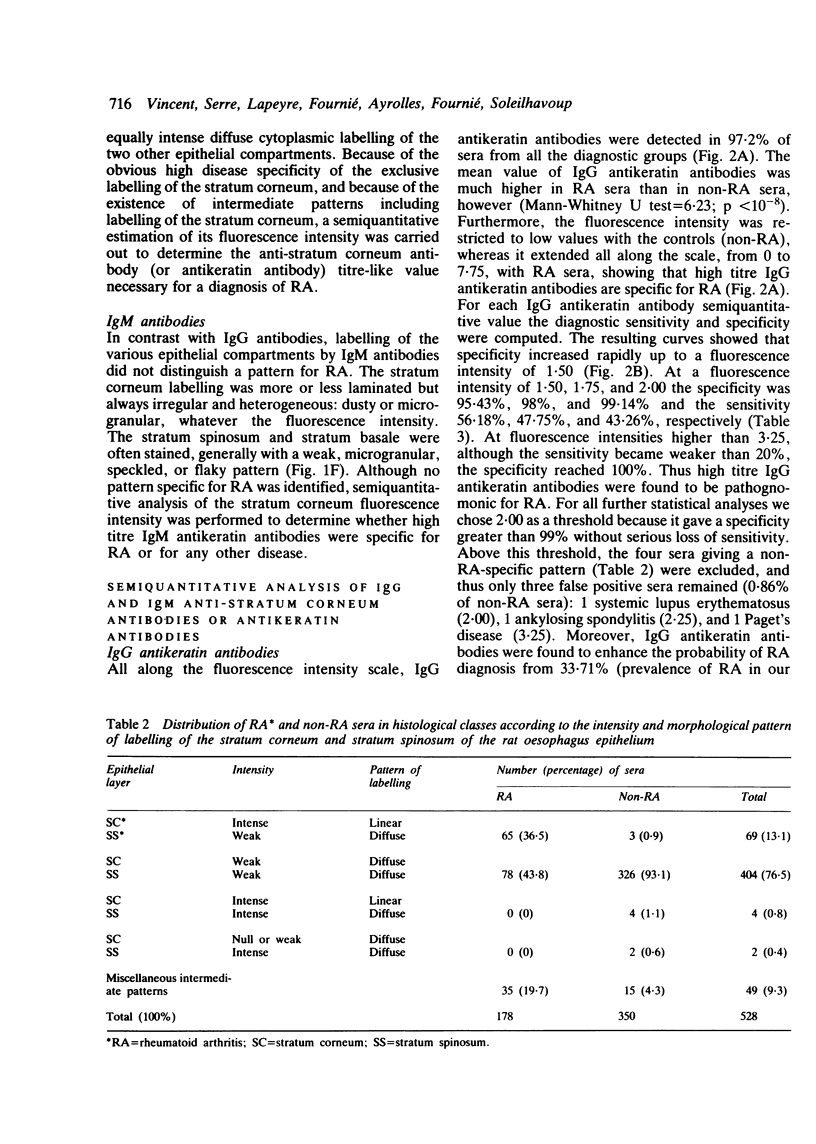
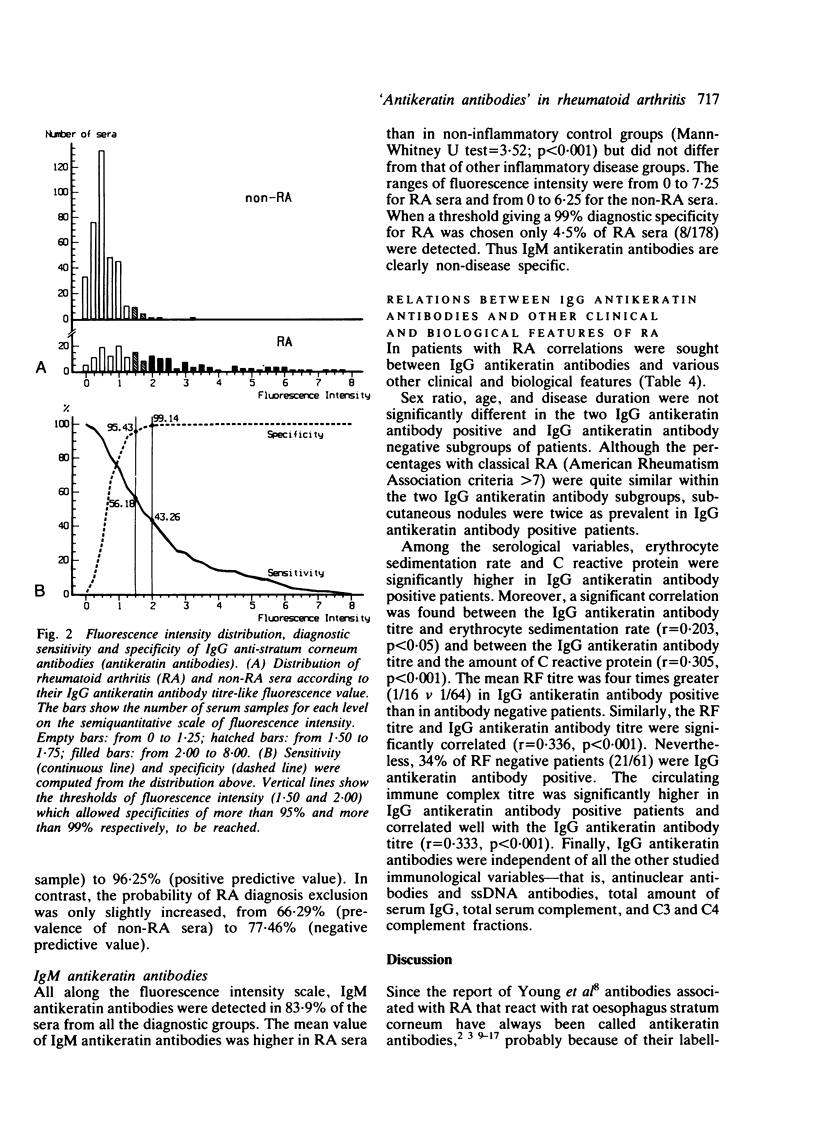
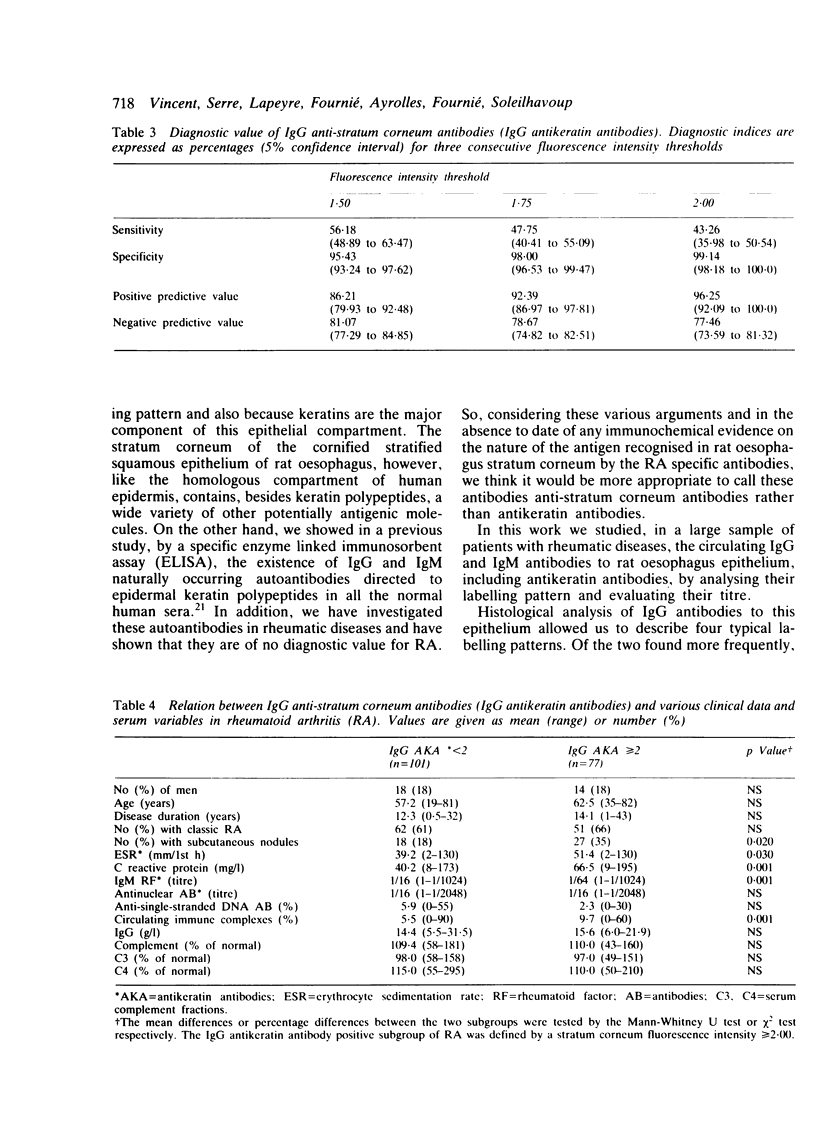
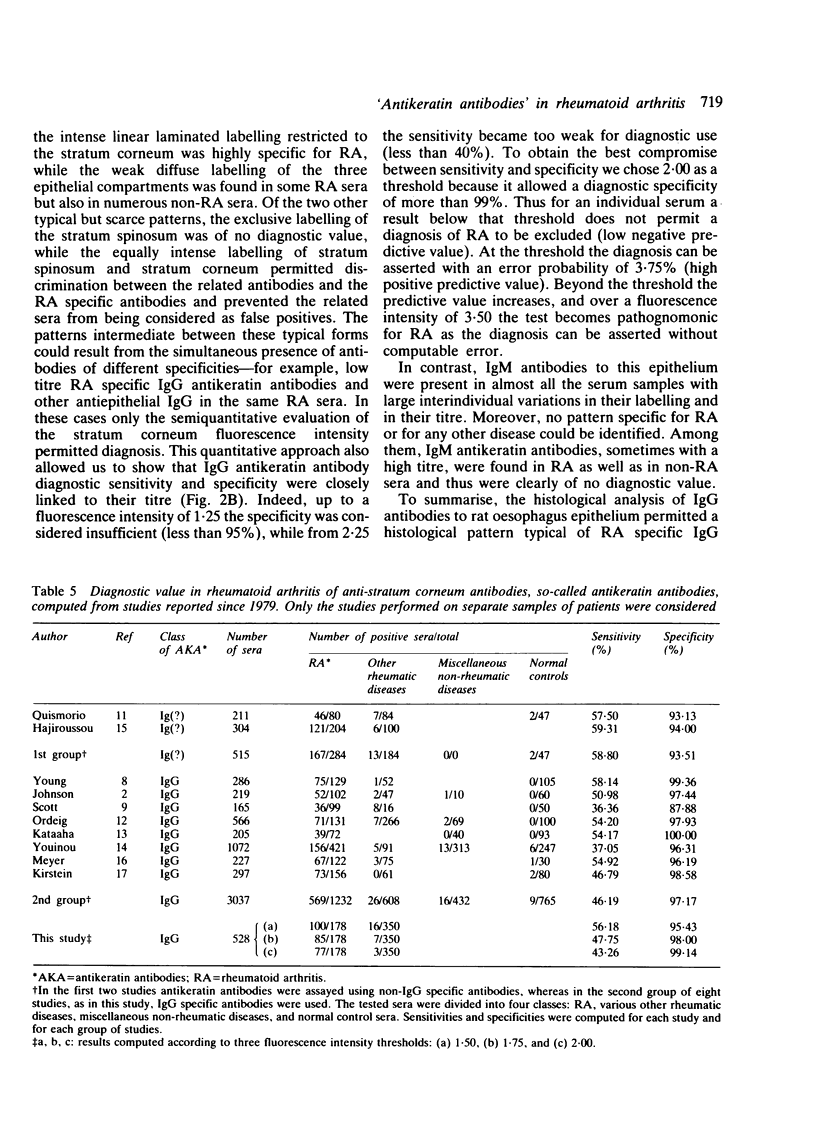
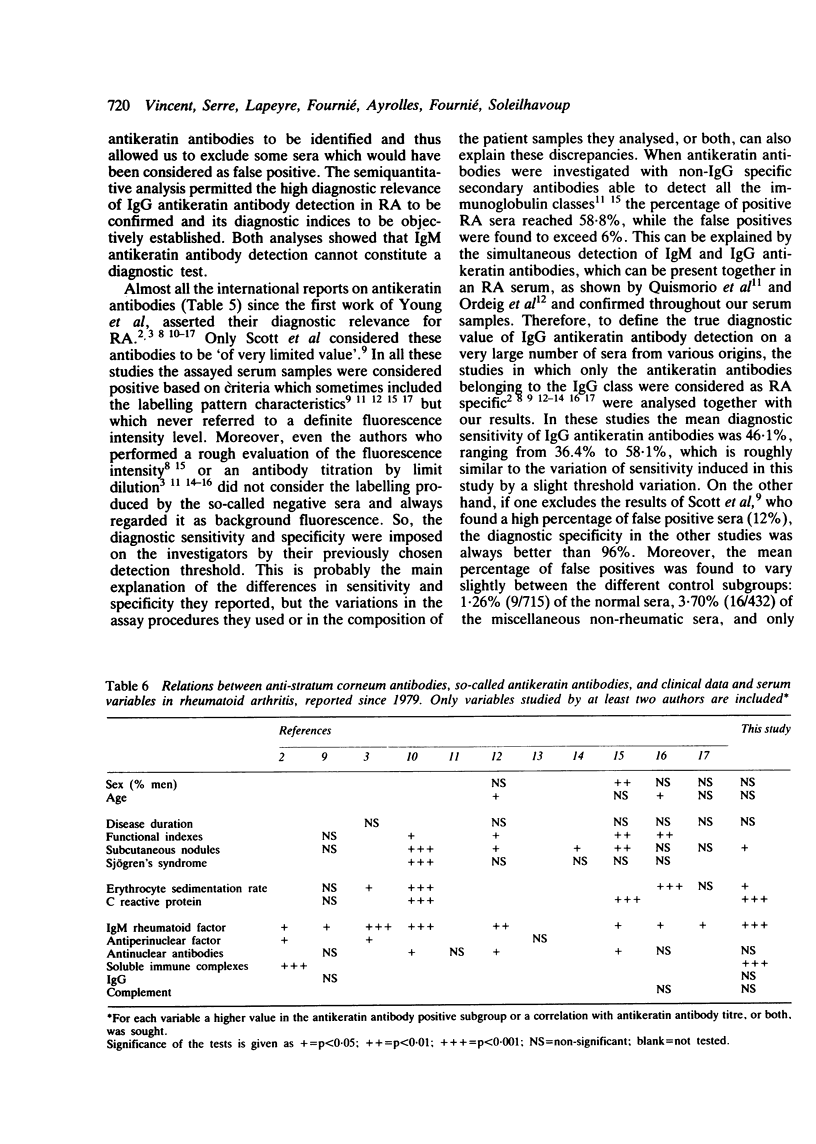
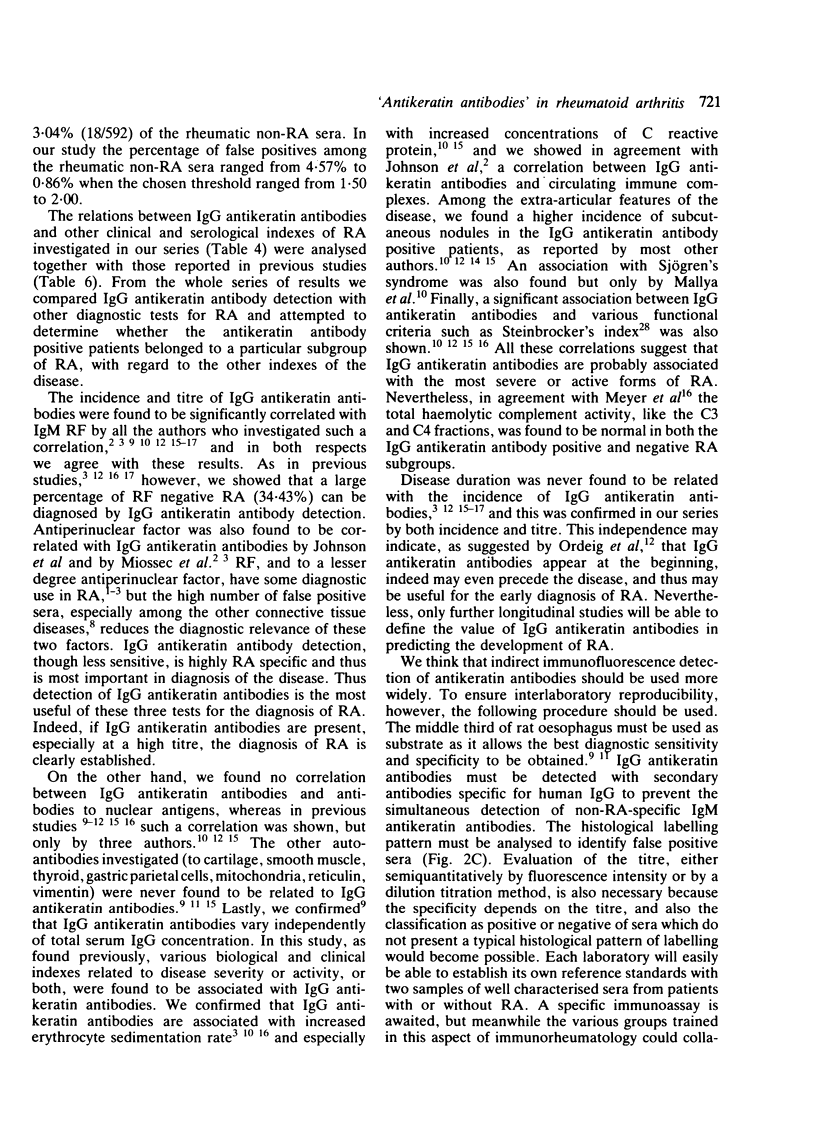
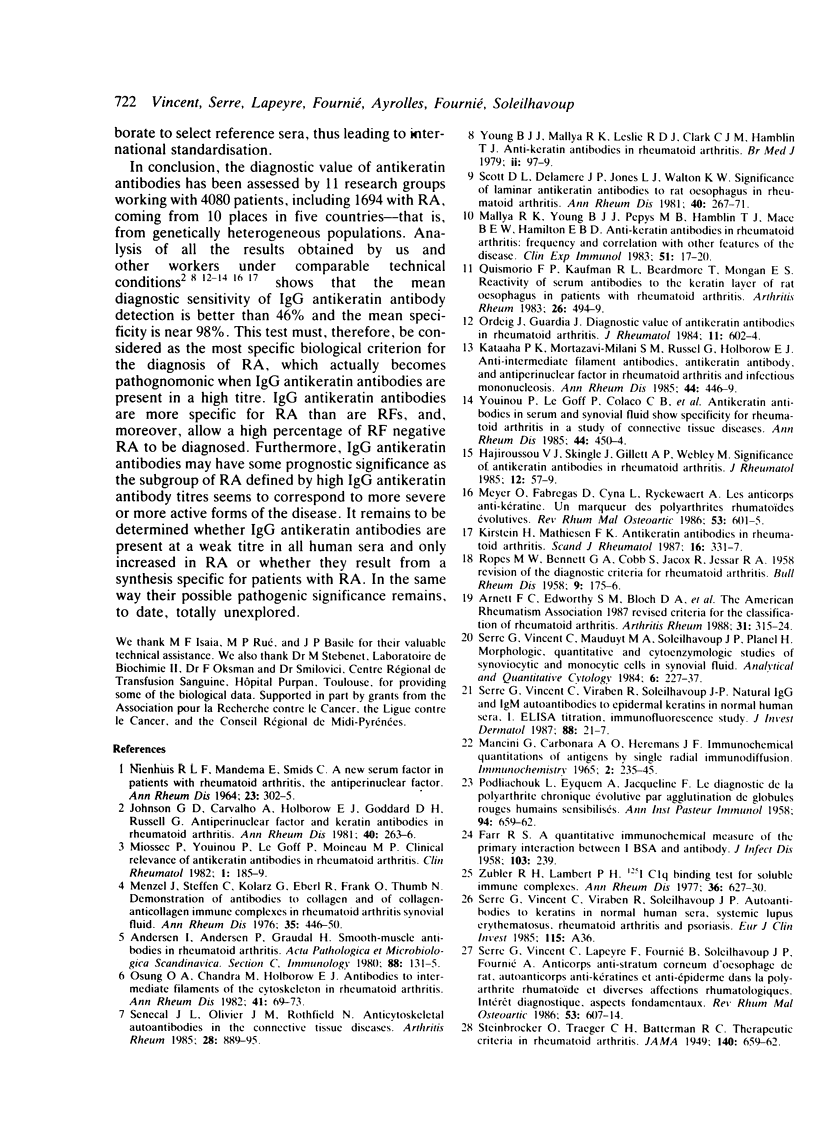
Images in this article
Selected References
These references are in PubMed. This may not be the complete list of references from this article.
- Arnett F. C., Edworthy S. M., Bloch D. A., McShane D. J., Fries J. F., Cooper N. S., Healey L. A., Kaplan S. R., Liang M. H., Luthra H. S. The American Rheumatism Association 1987 revised criteria for the classification of rheumatoid arthritis. Arthritis Rheum. 1988 Mar;31(3):315–324. doi: 10.1002/art.1780310302. [DOI] [PubMed] [Google Scholar]
- FARR R. S. A quantitative immunochemical measure of the primary interaction between I BSA and antibody. J Infect Dis. 1958 Nov-Dec;103(3):239–262. doi: 10.1093/infdis/103.3.239. [DOI] [PubMed] [Google Scholar]
- Johnson G. D., Carvalho A., Holborow E. J., Goddard D. H., Russell G. Antiperinuclear factor and keratin antibodies in rheumatoid arthritis. Ann Rheum Dis. 1981 Jun;40(3):263–266. doi: 10.1136/ard.40.3.263. [DOI] [PMC free article] [PubMed] [Google Scholar]
- Kirstein H., Mathiesen F. K. Antikeratin antibodies in rheumatoid arthritis. Methods and clinical significance. Scand J Rheumatol. 1987;16(5):331–338. doi: 10.3109/03009748709102504. [DOI] [PubMed] [Google Scholar]
- Mallya R. K., Young B. J., Pepys M. B., Hamblin T. J., Mace B. E., Hamilton E. B. Anti-keratin antibodies in rheumatoid arthritis: frequency and correlation with other features of the disease. Clin Exp Immunol. 1983 Jan;51(1):17–20. [PMC free article] [PubMed] [Google Scholar]
- Menzel J., Steffen C., Kolarz G., Eberal G., Frank O., Thumb N. Demonstration of antibodies to collagen and of collagen-anticollagen immune complexes in rheumatoid arthritis synovial fluids. Ann Rheum Dis. 1975 Oct;35(5):446–450. doi: 10.1136/ard.35.5.446. [DOI] [PMC free article] [PubMed] [Google Scholar]
- Meyer O., Fabregas D., Cyna L., Ryckewaert A. Les anticorps anti-kératine. Un marqueur des polyarthrites rhumatoïdes évolutives. Rev Rhum Mal Osteoartic. 1986 Nov;53(11):601–605. [PubMed] [Google Scholar]
- Miossec P., Youinou P., Le Goff P., Moineau M. P. Clinical relevance of antikeratin antibodies in rheumatoid arthritis. Clin Rheumatol. 1982 Sep;1(3):185–189. doi: 10.1007/BF02042772. [DOI] [PubMed] [Google Scholar]
- NIENHUIS R. L., MANDEMA E. A NEW SERUM FACTOR IN PATIENTS WITH RHEUMATOID ARTHRITIS; THE ANTIPERINUCLEAR FACTOR. Ann Rheum Dis. 1964 Jul;23:302–305. doi: 10.1136/ard.23.4.302. [DOI] [PMC free article] [PubMed] [Google Scholar]
- Ordeig J., Guardia J. Diagnostic value of antikeratin antibodies in rheumatoid arthritis. J Rheumatol. 1984 Oct;11(5):602–604. [PubMed] [Google Scholar]
- Osung O. A., Chandra M., Holborow E. J. Antibody to intermediate filaments of the cytoskeleton. Ann Rheum Dis. 1982 Feb;41(1):69–73. doi: 10.1136/ard.41.1.69. [DOI] [PMC free article] [PubMed] [Google Scholar]
- Quismorio F. P., Jr, Kaufman R. L., Beardmore T., Mongan E. S. Reactivity of serum antibodies to the keratin layer of rat esophagus in patients with rheumatoid arthritis. Arthritis Rheum. 1983 Apr;26(4):494–499. doi: 10.1002/art.1780260407. [DOI] [PubMed] [Google Scholar]
- ROPES M. W., BENNETT G. A., COBB S., JACOX R., JESSAR R. A. 1958 Revision of diagnostic criteria for rheumatoid arthritis. Bull Rheum Dis. 1958 Dec;9(4):175–176. [PubMed] [Google Scholar]
- Senécal J. L., Oliver J. M., Rothfield N. Anticytoskeletal autoantibodies in the connective tissue diseases. Arthritis Rheum. 1985 Aug;28(8):889–898. doi: 10.1002/art.1780280808. [DOI] [PubMed] [Google Scholar]
- Serre G., Vincent C., Fournié B., Lapeyre F., Soleilhavoup J. P., Fournié A. Anticorps anti-stratum corneum d'oesophage de rat, auto-anticorps anti-kératines épidermiques et anti-épiderme dans la polyarthrite rhumatoïde et différentes affections rhumatologiques. Intérêt diagnostique, aspects fondamentaux. Rev Rhum Mal Osteoartic. 1986 Nov;53(11):607–614. [PubMed] [Google Scholar]
- Serre G., Vincent C., Mauduyt M. A., Soleilhavoup J. P., Planel H. Morphologic, quantitative and cytoenzymologic studies of synoviocytic and monocytic cells in synovial fluid. Anal Quant Cytol. 1984 Dec;6(4):227–237. [PubMed] [Google Scholar]
- Youinou P., Le Goff P., Colaco C. B., Thivolet J., Tater D., Viac J., Shipley M. Antikeratin antibodies in serum and synovial fluid show specificity for rheumatoid arthritis in a study of connective tissue diseases. Ann Rheum Dis. 1985 Jul;44(7):450–454. doi: 10.1136/ard.44.7.450. [DOI] [PMC free article] [PubMed] [Google Scholar]



